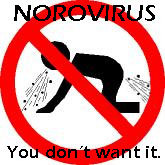Ingeborg et al. report in Food Control that Noroviruses (NoV) are among the most common causes of viral gastroenteritis (GE) worldwide and can be transmitted from person-to-person, via food or contaminated surfaces. The present study aimed to examine the prevalence of NoV RNA on surfaces in food preparation and sanitary areas in different health care settings and to compare the outcomes with the prevalence in nearby located catering companies, mainly restaurants, for general public, as sentinels.
 For this purpose, 1087 environmental swabs were taken for NoV analyses from surfaces in 241 institutional departments and 123 catering companies in The Netherlands without a recently reported outbreak of gastro-enteritis in high NoV season only. NoV RNA was detected in 15.1% of the 73 non-hospital health care institutions, 11.1% of the 54 hospital central kitchen departments, 14.9% of the 114 decentralized hospital kitchens (in-patient units) and 4.1% of the 123 nearby located catering companies. Twenty-five of the 49 positive environmental samples were genotyped by sequence analyses. In 7% of the investigated hospitals (4/58), NoV was detected in two or more departments. NoV prevalence was significantly lower in food preparation areas than in sanitary facilities (p < 0.05), but only in hospital central kitchen departments and non-hospital health care settings, and not in de-centralized hospital kitchens in in-patient units or in catering companies for the general public. This data suggests that there is a need for education on risks of NoV transmission by food handling of healthcare workers using in ward kitchen facilities.
For this purpose, 1087 environmental swabs were taken for NoV analyses from surfaces in 241 institutional departments and 123 catering companies in The Netherlands without a recently reported outbreak of gastro-enteritis in high NoV season only. NoV RNA was detected in 15.1% of the 73 non-hospital health care institutions, 11.1% of the 54 hospital central kitchen departments, 14.9% of the 114 decentralized hospital kitchens (in-patient units) and 4.1% of the 123 nearby located catering companies. Twenty-five of the 49 positive environmental samples were genotyped by sequence analyses. In 7% of the investigated hospitals (4/58), NoV was detected in two or more departments. NoV prevalence was significantly lower in food preparation areas than in sanitary facilities (p < 0.05), but only in hospital central kitchen departments and non-hospital health care settings, and not in de-centralized hospital kitchens in in-patient units or in catering companies for the general public. This data suggests that there is a need for education on risks of NoV transmission by food handling of healthcare workers using in ward kitchen facilities.
Environmental testing for norovirus in various institutional settings using catering companies as sentinels for norovirus prevalence among the general population
ScienceDirect
Ingeborg L.A. Boxmana, Linda Verhoefb, Geke Hägelea, Kyara Klundera, Nathalie A.J.M. te Loekea, Harry Vennemab, Claudia C.C. Jansena, Marion Koopmans
Food Control, Volume 47, January 2015, Pages 98–102, DOI: 10.1016/j.foodcont.2014.06.026
http://www.sciencedirect.com/science/article/pii/S0956713514003557
